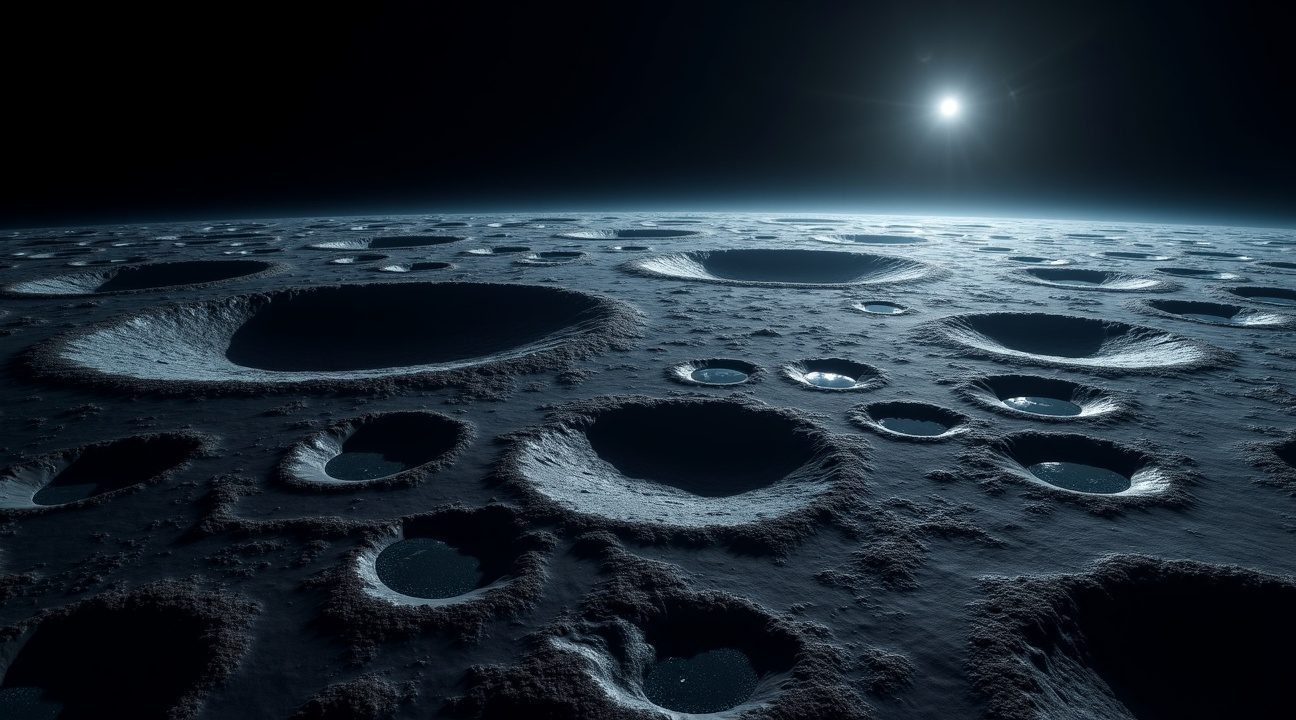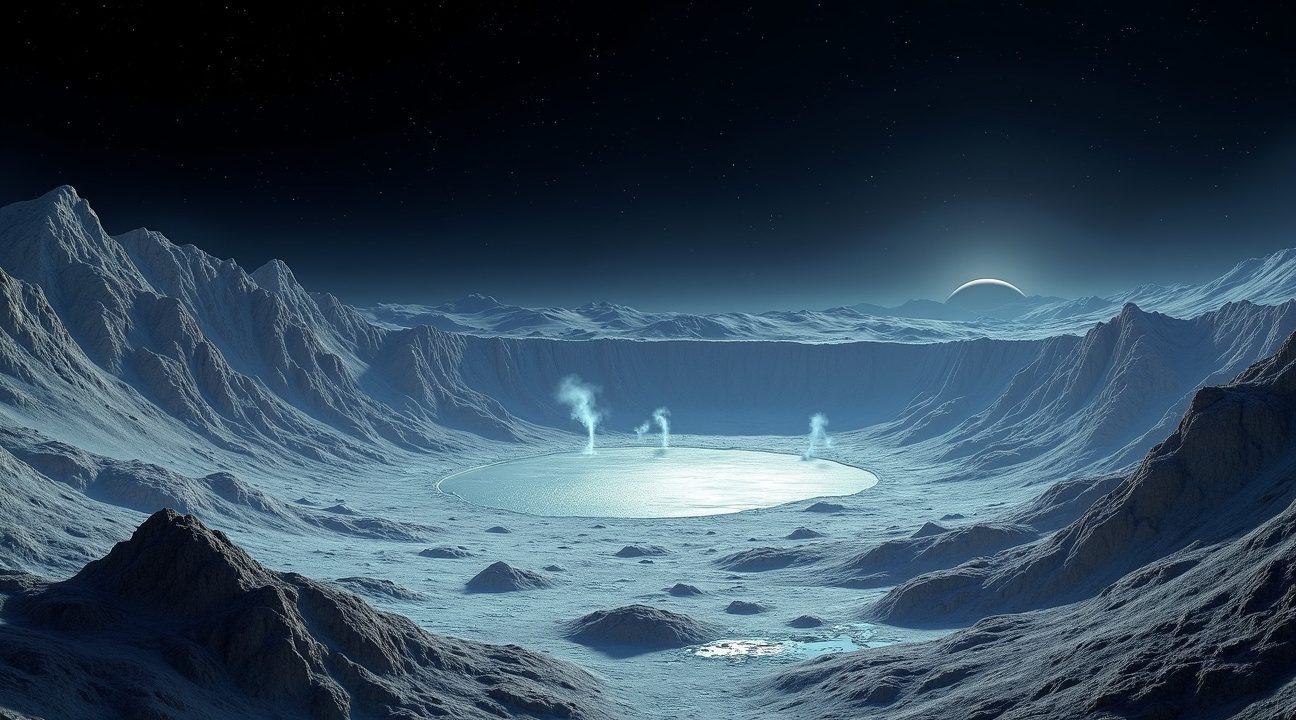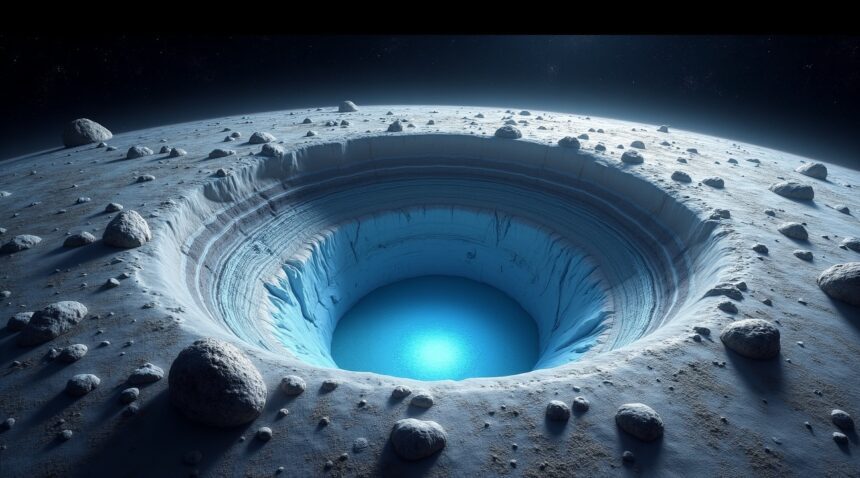NASA’s Dawn mission has revolutionized our perception of ocean worlds with its discovery that Ceres, the largest object in the asteroid belt, once bore a vast global subsurface ocean beneath its icy surface.
Key Takeaways
- Ceres contains a 90% ice composition near its surface, with increasing impurities down to 117 kilometers depth, suggesting a top-down freezing process of its ancient ocean.
- The dwarf planet sustained hydrothermal activity for over 2 billion years through radioactive decay, giving rise to bright sodium carbonate salt deposits where briny water reached the surface.
- Ceres’ ocean was muddy and impurity-rich, filled with salts, rocks, and debris, unlike the cleaner ice environments of Europa or Enceladus, distinguishing it from other ocean worlds.
- The discovery implies Ceres had the three essential ingredients for life—liquid water, chemical energy, and organic compounds—indicating it may have been habitable in its distant past.
- Ceres is located just 2.8 astronomical units from Earth, making it the most accessible ocean world for future exploration when compared to the distant moons of Jupiter and Saturn.
Learn More About Dawn
To explore more about NASA’s mission and its groundbreaking findings, you can visit the NASA Dawn Mission page.
NASA’s Dawn Mission Reveals Ceres’ Shocking Secret
I discovered through NASA’s Dawn spacecraft that Ceres holds one of the most surprising secrets in our solar system. Dawn made history by becoming the first mission to orbit a dwarf planet in the inner solar system, spending years collecting detailed data about Ceres’ surface and hidden interior. This groundbreaking mission transformed our understanding of what appeared to be just another rocky asteroid into something far more extraordinary.
Ceres commands attention as the largest object residing in the asteroid belt between Mars and Jupiter. At roughly 590 miles (950 kilometers) in diameter, this dwarf planet spans an area comparable to Texas. The massive celestial body contains approximately one-third of the entire asteroid belt’s total mass, making it a dominant force in this region of space.
A Muddy Ocean Unlike Any Other
Dawn’s data revealed that Ceres likely harbored a global subsurface ocean, but this wasn’t the pristine water ice found on other ocean worlds. Instead, evidence points to a muddy, impurity-rich ocean containing salts, rocks, and various debris. This murky composition sets Ceres apart from cleaner ice environments suspected on moons like Europa or Enceladus.
The spacecraft’s instruments detected bright spots on Ceres’ surface that turned out to be salt deposits, likely remnants from this ancient ocean. These deposits suggest that briny water once percolated up through cracks in the dwarf planet’s crust, leaving behind mineral signatures that tell the story of Ceres’ watery past.
Dawn’s findings indicate that Ceres represents a unique category of protoplanet — one that retained significant amounts of water ice during the early solar system’s formation. Unlike other asteroids that became completely dry and rocky, Ceres managed to preserve its icy composition, creating conditions suitable for a subsurface ocean to exist for millions of years.
This discovery reshapes how I view the asteroid belt, transforming it from a collection of dry, lifeless rocks into a region that once hosted dynamic, water-rich worlds. Ceres demonstrates that ocean worlds might be more common than previously thought, extending the possibilities for where life’s building blocks could have emerged in our cosmic neighborhood.

The Frozen Ocean Beneath Our Feet
Ceres harbors one of the most fascinating examples of planetary evolution in our solar system, where a once-liquid ocean has undergone a dramatic transformation over billions of years. I find it remarkable that this dwarf planet’s crust consists of approximately 90% ice near the surface, creating a frozen remnant of what scientists believe was once a thriving subsurface ocean.
A Gradient of Ancient Waters
The composition of Ceres tells a compelling story of gradual change. As researchers probe deeper into its structure, they discover that impurity content steadily increases with depth, reaching approximately 117 kilometers below the surface where rock begins to dominate the composition. This gradient pattern supports a fascinating model of top-down freezing, where an ancient ocean slowly solidified from the surface downward as the dwarf planet’s internal heat diminished over geological time.
Unlike Jupiter’s moon Europa, which maintains its liquid ocean through tidal heating from its massive host planet, Ceres experienced a different fate. The dwarf planet’s ocean gradually froze as its internal heat sources weakened, creating what scientists now recognize as a muddy ocean that became increasingly concentrated with impurities during the solidification process.
Evidence Written in Ice and Rock
The ice-rich crust extends down to that critical 117-kilometer depth, where it transitions into a denser, rockier layer beneath. This dramatic change in composition provides compelling evidence for Ceres’ water-rich past, supported by both density data and observable surface features that point to extensive water activity in its history.
What makes Ceres particularly intriguing is how this dirty ice composition differs from the cleaner ice shells found on other ocean worlds. The increasing impurity content with depth suggests that as the original ocean froze from the top down, dissolved materials became more concentrated in the remaining liquid, eventually creating the ice-rock mixture scientists observe today. This process offers valuable insights into how planetary bodies with substantial water content evolve when they lack the gravitational influences that keep other ocean worlds liquid.
Mysterious Bright Spots Tell a Story of Ancient Activity
I find myself captivated by the brilliant white patches scattered across Ceres’ otherwise dark surface, which serve as windows into the dwarf planet’s potentially watery past. These bright areas consist primarily of sodium carbonate salts, remnants of an extraordinary process where briny water from deep underground made its way to the surface and evaporated under the harsh conditions of space.
The most spectacular collection of these reflective deposits sits within Occator Crater, a massive 92-kilometer-wide impact feature that dominates Ceres’ landscape. I observe how this crater acts like a natural laboratory, preserving evidence of the dwarf planet’s internal processes and revealing secrets that have been locked away for eons.
Data analysis reveals something remarkable about the origin of these salt deposits. The briny water that created them didn’t come from shallow underground pools, but rather from a vast deep reservoir stretching up to 25 miles (40 km) below the surface and extending hundreds of miles in width. This discovery fundamentally changes how I understand Ceres’ internal structure and its potential for harboring liquid water over geological timescales.
Ancient Heat Sources Powered Subsurface Activity
Hydrothermal activity appears to have sustained these underground processes for an astounding period. Evidence suggests that radioactive decay within Ceres provided the necessary heat to maintain this activity for over 2 billion years. I consider how this extended timeframe represents roughly half of the solar system’s existence, indicating that Ceres maintained dynamic internal processes far longer than scientists initially expected for such a small body.
The energy from radioactive decay created conditions that allowed subsurface fluids to rise and circulate throughout Ceres’ interior. This circulation system would have transported dissolved minerals and salts from deep within the dwarf planet to areas closer to the surface, where impact events like the one that created Occator Crater could expose them to space.
On Earth, similar hydrothermal environments represent some of our planet’s most productive habitats for microbial life. Scientists find essential building blocks in various locations throughout our solar system, suggesting that the conditions observed on Ceres might have supported habitability in the distant past.
The implications stretch far beyond simple geology. If Ceres maintained liquid water reservoirs for billions of years, with chemical energy sources available through hydrothermal processes, the dwarf planet could have provided the three key ingredients scientists consider necessary for life:
- Liquid water
- Chemical energy
- Organic compounds
The sodium carbonate deposits themselves indicate that complex chemical reactions occurred within Ceres’ subsurface environment, potentially creating conditions where life might have emerged and thrived.
Modern instruments continue to study these bright spots, revealing new details about their composition and formation. The precision of these observations allows scientists to reconstruct not just what happened on Ceres, but when it happened and for how long. Each bright patch tells part of a larger story about water activity, internal heating, and the potential for habitability on what was once considered a simple asteroid.
The discovery transforms Ceres from a minor solar system object into a compelling target for future exploration. Understanding how such a small body maintained active hydrothermal systems for billions of years provides crucial insights into the conditions that might exist on other dwarf planets and large asteroids throughout our solar system and beyond.

Could Life Have Existed in Ceres’ Ancient Ocean
The discovery that Ceres once harbored a substantial ocean has fundamentally shifted our understanding of where life might emerge in our solar system. This revelation is particularly compelling because it suggests that habitable environments existed much closer to Earth than previously imagined, challenging long-held assumptions about the rarity of ocean worlds.
The Perfect Storm for Early Life
Ceres’ ancient ocean likely possessed several key ingredients that astrobiologists consider essential for life’s emergence. The chemical interactions between liquid water and the rocky mantle would have created a dynamic environment rich in dissolved minerals and organic compounds. This process mirrors what we observe around hydrothermal systems on other celestial bodies, where energy gradients provide the chemical fuel that microorganisms require.
The dwarf planet’s internal structure would have facilitated extensive water-rock interactions during its ocean phase. As liquid water percolated through Ceres’ rocky interior, it would have leached out essential elements like sulfur, phosphorus, and various metals that form the backbone of biological processes. These conditions could have supported chemosynthetic life forms similar to those thriving around Earth’s deep-sea hydrothermal vents, where sunlight never penetrates but life flourishes nonetheless.
Temperature gradients within Ceres’ ocean would have created convection currents, ensuring that nutrients and chemical compounds remained in constant circulation. This mixing process is crucial for maintaining the chemical disequilibrium that life depends upon for energy. The relatively modest gravity on Ceres might have actually enhanced these mixing processes, creating unique conditions that don’t exist on larger planetary bodies.
Modern Remnants and Ongoing Potential
While Ceres’ grand ocean has largely frozen, the story of potential habitability hasn’t necessarily ended. Deep beneath the icy surface, pockets of briny water may persist in isolated reservoirs, protected by the insulating properties of the overlying ice and rock. These brine pockets could maintain liquid conditions through a combination of residual internal heat and the antifreeze properties of dissolved salts.
The subsurface environment of modern Ceres presents intriguing possibilities for extremophile microorganisms. Even with limited internal heat generation, radioactive decay within the rocky core continues to provide energy input to the system. This energy source, though modest compared to the dwarf planet’s more active past, could still drive slow chemical processes in any remaining liquid reservoirs.
Recent observations have revealed seasonal changes in water vapor emissions from Ceres’ surface, suggesting that liquid water still occasionally reaches the surface through fractures and sublimation processes. These active water cycles indicate that the boundary between solid and liquid phases remains dynamic, potentially creating temporary habitable niches.
The implications extend far beyond Ceres itself. If this relatively small dwarf planet could maintain ocean conditions for extended periods, similar processes likely occurred throughout the outer solar system. Future missions to other icy bodies may reveal that ocean worlds represent the norm rather than the exception among small planetary bodies.
The discovery also reshapes our approach to planetary evolution and habitability. Rather than focusing exclusively on planets within traditional habitable zones, astrobiologists now recognize that internal heat sources can maintain liquid water reservoirs across vast distances from host stars. This expanded definition of habitability multiplies the potential locations where life might emerge and persist.
Ceres demonstrates that ocean worlds need not be exotic or distant phenomena. The chemical processes that once sustained its ocean operated using the same fundamental principles that govern habitability elsewhere in the solar system, from Europa’s subsurface seas to Enceladus’ hydrothermal activity. Understanding these processes on Ceres provides valuable insights into the broader question of life’s potential distribution throughout our cosmic neighborhood.
How Ceres Stacks Up Against Other Ocean Worlds
Ceres stands out as the most accessible ocean world for future exploration, sitting just 2.8 astronomical units from Earth compared to Jupiter’s Europa at 5.2 AU or Saturn’s Enceladus at 9.5 AU. This proximity makes Ceres an attractive target for missions that could provide insights into ocean world dynamics without the extreme distances and radiation challenges faced at the outer planets.
Comparative Analysis of Solar System Ocean Worlds
The key differences between these celestial bodies reveal fascinating variations in how ocean worlds evolve and maintain their subsurface seas:
- Ceres maintains a frozen, briny ocean state powered primarily by radioactive decay, with 90% ice composition near the surface creating a muddy ice mixture and distinctive bright salt deposits marking ancient ocean activity.
- Europa sustains a liquid, salty ocean through constant tidal flexing from Jupiter’s gravitational pull, hidden beneath a thick water-ice shell that occasionally erupts in dramatic plumes and potentially harbors life-supporting zones.
- Enceladus operates similarly to Europa but under Saturn’s influence, featuring an icy crust enriched with organic materials and spectacular water plumes that have captivated scientists studying essential building blocks for life.
- Pluto possibly harbors a liquid ocean sustained by residual radioactive decay beneath its nitrogen and water-ice crust, representing one of the most distant potential ocean worlds in our solar system.
Unlike its dynamic cousins that maintain active liquid states, Ceres offers researchers a frozen snapshot of ocean world evolution. This unique characteristic provides valuable insights into what Europa, Enceladus, and other active ocean worlds might eventually become as their internal heat sources diminish over geological time scales.
Ceres’ accessibility combined with its preserved ocean history makes it an ideal laboratory for understanding ocean world processes. Future missions could study its composition and structure with relative ease compared to the complex orbital mechanics and harsh radiation environments surrounding Jupiter and Saturn. The dwarf planet’s intermediate state between active and completely frozen ocean worlds positions it as a crucial piece in understanding how these fascinating celestial bodies evolve throughout the solar system’s history.
Sources:
Astronomy – “Ceres: An ocean world in the asteroid belt”
NASA – “Bright Areas on Ceres Come from Salty Water Below”
NASA – “Ceres May Have Had Long-Standing Energy to Fuel Habitability”
Sci.News – “Ceres: Former Ocean World”
Big Think – “Ceres: Asteroid Belt Ocean World”
Purdue University – “Asteroid Ceres is a Former Ocean World”
Nature – “Dwarf Planet Ceres Muddy Ocean Study”
Space.com – “Dwarf Planet Ceres Muddy Ocean Study”

